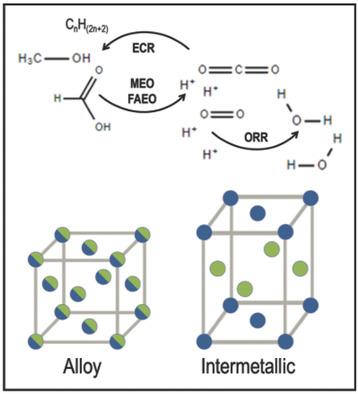当前位置:
X-MOL 学术
›
Adv. Mater.
›
论文详情
Our official English website, www.x-mol.net, welcomes your
feedback! (Note: you will need to create a separate account there.)
Random Alloyed versus Intermetallic Nanoparticles: A Comparison of Electrocatalytic Performance
Advanced Materials ( IF 27.4 ) Pub Date : 2018-07-09 , DOI: 10.1002/adma.201801563 Jocelyn T L Gamler 1 , Hannah M Ashberry 1 , Sara E Skrabalak 1 , Kallum M Koczkur 1
Advanced Materials ( IF 27.4 ) Pub Date : 2018-07-09 , DOI: 10.1002/adma.201801563 Jocelyn T L Gamler 1 , Hannah M Ashberry 1 , Sara E Skrabalak 1 , Kallum M Koczkur 1
Affiliation

|
As synthetic methods advance for metal nanoparticles, more rigorous studies of structure–function relationships can be made. Many electrocatalytic processes depend on the size, shape, and composition of the nanocatalysts. Here, the properties and electrocatalytic behavior of random alloyed and intermetallic nanoparticles are compared. Beginning with an introduction of metallic nanoparticles for catalysis and the unique features of bimetallic compositions, the discussion transitions to case studies of nanoscale electrocatalysts where direct comparisons of alloy and intermetallic compositions are undertaken for methanol electrooxidation, formic acid electrooxidation, the oxygen reduction reaction, and the electroreduction of carbon dioxide (CO2). Design and synthesis strategies for random alloyed and intermetallic nanoparticles are discussed, with an emphasis on Pt–M and Cu–M compositions as model systems. The differences in catalytic performance between alloys and intermetallic nanoparticles are highlighted in order to provide an outlook for future electrocatalyst design.
中文翻译:

随机合金纳米颗粒与金属间纳米颗粒:电催化性能的比较
随着金属纳米颗粒合成方法的进步,可以对结构-功能关系进行更严格的研究。许多电催化过程取决于纳米催化剂的尺寸、形状和成分。在这里,比较了随机合金纳米颗粒和金属间纳米颗粒的性能和电催化行为。首先介绍用于催化的金属纳米粒子和双金属组合物的独特特征,讨论转向纳米级电催化剂的案例研究,其中直接比较合金和金属间化合物的甲醇电氧化、甲酸电氧化、氧还原反应和二氧化碳(CO 2 )的电还原。讨论了随机合金和金属间纳米颗粒的设计和合成策略,重点是 Pt-M 和 Cu-M 成分作为模型系统。强调了合金和金属间纳米粒子之间催化性能的差异,以便为未来的电催化剂设计提供展望。
更新日期:2018-07-09
中文翻译:

随机合金纳米颗粒与金属间纳米颗粒:电催化性能的比较
随着金属纳米颗粒合成方法的进步,可以对结构-功能关系进行更严格的研究。许多电催化过程取决于纳米催化剂的尺寸、形状和成分。在这里,比较了随机合金纳米颗粒和金属间纳米颗粒的性能和电催化行为。首先介绍用于催化的金属纳米粒子和双金属组合物的独特特征,讨论转向纳米级电催化剂的案例研究,其中直接比较合金和金属间化合物的甲醇电氧化、甲酸电氧化、氧还原反应和二氧化碳(CO 2 )的电还原。讨论了随机合金和金属间纳米颗粒的设计和合成策略,重点是 Pt-M 和 Cu-M 成分作为模型系统。强调了合金和金属间纳米粒子之间催化性能的差异,以便为未来的电催化剂设计提供展望。











































 京公网安备 11010802027423号
京公网安备 11010802027423号